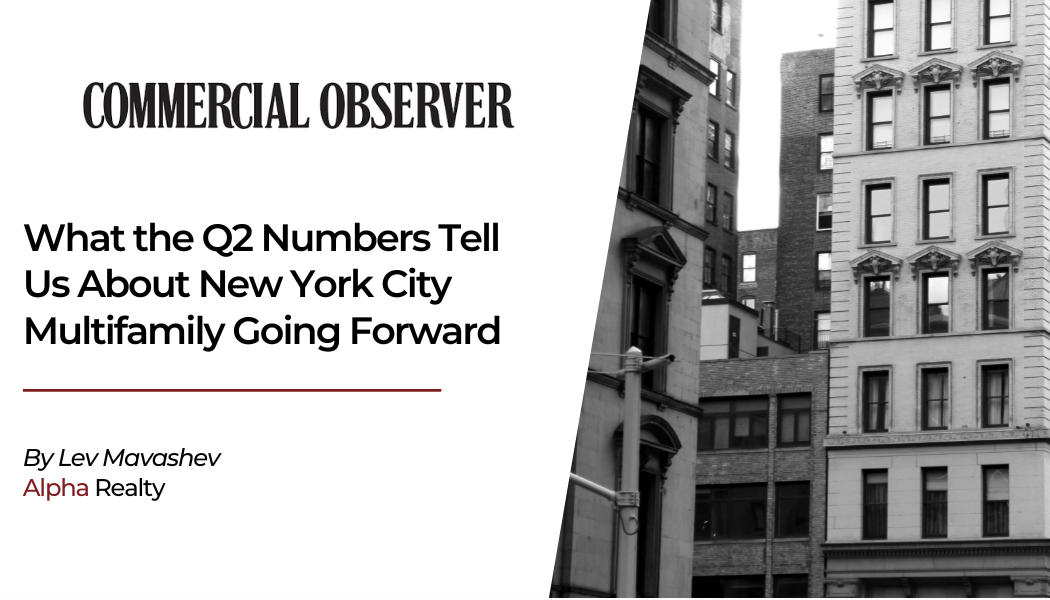By Lev Mavashev
After two years of choppy waters, Q2 tells a clearer story: New York City’s multifamily market is moving again—and fast. Deal count surged to 297 transactions, marking a 29.1% jump from the previous quarter and a 52.3% increase year-over-year. Yet total dollar volume barely budged, rising just 3.8% quarter-over-quarter, while the average ticket size fell 19.6%. The takeaway is simple: buyers are back, but they’re prioritizing value and execution over splashy, high-dollar deals.
The strongest momentum came from larger buildings. Trades of 20+ unit assets nearly doubled, reaching 103 in Q2, while dollar volume in that segment rose a modest 18.3%. This highlights a clear preference for scale at today’s reset pricing rather than yesterday’s inflated values. By contrast, 10–19 unit deals saw a sharp 39.8% drop in dollar volume, while sub-10 unit transactions gained in both count and dollars as private capital continued to chase financeable, bite-sized opportunities.
No borough embodied this acceleration more than The Bronx. Transactions more than doubled to 74 deals, with total dollar volume soaring 314% to $401.5 million. Importantly, this was not just churn among smaller walk-ups; 60 of those trades were 20+ unit properties, showing that institutional-style product is firmly back in play north of the Cross Bronx Expressway.
Manhattan, meanwhile, showed more selective activity. Transaction count inched up 3.7% to 56 deals, but dollar volume fell 42.4% as the average deal size slid to $7.5 million. Much of that decline came from a steep drop in large and mid-size transactions. Yet smaller properties quietly gained traction: the sub-10 unit segment grew dollar volume by 10%, signaling that family offices and boutique institutions are re-engaging at the more approachable scale.
Brooklyn continues to be the workhorse of the market. The borough logged 129 transactions, up 29% quarter-over-quarter and 95.5% year-over-year, with 1,620 units changing hands. Average deal size compressed to $4.2 million, consistent with the citywide theme of “more trades, smaller checks.” Notably, dollar volume in the 10–19 unit segment more than doubled, while 20+ unit sales dipped—a classic mid-market rotation into more executable, value-add opportunities.
Queens presented a different dynamic. The borough posted an 11.6% drop in trades but a 24.6% increase in dollar volume. Average deal size climbed 41% to $5.1 million, largely driven by strong activity in larger properties, where 20+ unit dollar volume rose 63%. Queens demonstrated that scale paired with strong fundamentals around transit and cash flow still commands firm pricing.
For buyers, the message is to follow the velocity, not just the headlines. Risk is being repriced at the operating level, and Q2’s surge in deal activity confirms that capital is transacting on cash flow, business plans, and achievable basis. In The Bronx, the hottest market this quarter, post-2010 stock and stabilized 20+ unit buildings stand out as prime targets for investors who can support professional management and debt service from day one. In Brooklyn, the sweet spot lies in mid-market properties—specifically the 10–19 unit category, which doubled in dollar volume this quarter. Sophisticated local capital is active here, so the edge will come not just from pricing but from speed, certainty, and strong terms. In Manhattan, the small building segment is quietly showing durability. Sub-10 unit properties, often estate sales or long-held assets, are finding liquidity, offering upside opportunities overlooked by larger institutional players.
For sellers, Q2 provided an equally clear message. Average price per transaction fell nearly 20%, even as overall activity rose. Sellers who continue to anchor to 2021 comparables risk sitting on the sidelines, while those who price to today’s clearing levels are fielding multiple qualified offers. Large-asset buyers are returning, but at tighter checks, making it critical for sellers to package assets with transparency and lender-friendly materials such as updated financials, unit-by-unit detail, and energy efficiency upgrades. In certain boroughs—Queens in particular—capital is proving it will pay up for clarity and location. In The Bronx, where 20+ unit buyers are most active, controlled processes and quiet matchmaking tours are outperforming broad blasts, often compressing the time to best-and-final.
The big read on Q2 is that velocity is leading price. The surge in trades shows sentiment has already shifted; pricing will follow in submarkets where operations and financing align with current rents and taxes. For buyers, this is a basis window before cap rate compression shows up in the comps. For sellers with clean, cash-flowing assets, there is finally enough market depth to run a competitive process—provided you meet the market where it stands today.
If you own, operate, or are planning to deploy capital into NYC multifamily, now is the time to align your portfolio with the Q2 heat map. The market has momentum, and the next leg of recovery will favor those who act early.
–
Lev Mavashev is founder and principal of Alpha Realty, a New York brokerage focusing on multifamily.
Source: “What the Q2 Numbers Tell Us About New York City Multifamily Going Forward” Lev Mavashev, Commercial Observer, September 1, 2025.


